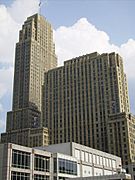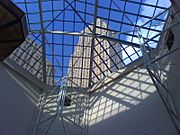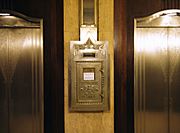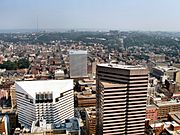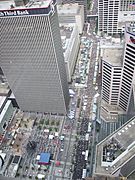Carew Tower facts for kids
Quick facts for kids Carew Tower |
|
|---|---|
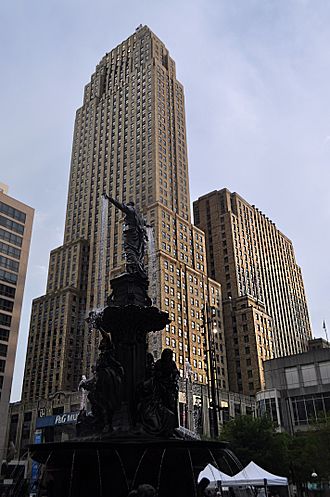 |
|
| General information | |
| Status | Complete |
| Type | Commercial offices |
| Architectural style | Art Deco |
| Location | 441 Vine Street Cincinnati, Ohio |
| Coordinates | 39°06′03″N 84°30′48″W / 39.1007°N 84.5132°W |
| Construction started | 1927 |
| Completed | 1930 |
| Cost | US$33 million |
| Height | |
| Antenna spire | 190 m (623 ft) |
| Roof | 175 m (574 ft) |
| Top floor | 171.3 m (562 ft) |
| Technical details | |
| Floor count | 49 |
| Floor area | 128,000 m2 (1,377,780.5 sq ft) |
| Lifts/elevators | 14 |
| Design and construction | |
| Architect | W.W. Ahlschlager & Associates Delano & Aldrich |
| Developer | John J. Emery |
| Main contractor | Starrett Investment Corp. Col. William A. Starrett |
|
Carew Tower-Netherland Plaza Hotel
|
|
| Area | 10 acres (4.0 ha) |
| NRHP reference No. | 82003578 |
| Significant dates | |
| Added to NRHP | August 5, 1982 |
| Designated NHL | April 19, 1994 |
The Carew Tower is a very tall building in Cincinnati, Ohio. It has 49 floors and stands 574-foot (175 m) high. This amazing building was finished in 1930. It is a great example of the Art Deco style.
The Carew Tower is the second tallest building in Cincinnati. It looks out over the Ohio River. On April 19, 1994, it became a National Historic Landmark. This means it is a very important historical place. The tower is named after Joseph T. Carew. He owned a department store called Mabley & Carew. His store used to be on this very spot.
Inside the complex is the Hilton Cincinnati Netherland Plaza hotel. This hotel is famous for its beautiful French Art Deco design. The hotel's Hall of Mirrors banquet room was inspired by the real Hall of Mirrors in France. The Hilton Cincinnati Netherland Plaza is also part of Historic Hotels of America. This group protects important historic hotels.
For a long time, the Carew Tower was the tallest building in Cincinnati. This changed on July 13, 2010. That's when the Great American Tower at Queen City Square was finished. It is 86 ft (26 m) taller than the Carew Tower. Before this, Cincinnati was one of the few big American cities. Its tallest building was built before World War II.
Contents
Building the Carew Tower
How the Tower Was Designed
The Carew Tower was designed by W.W. Ahlschlager & Associates. They worked with another firm called Delano & Aldrich. John J. Emery was the person who developed the project. He wanted to build a huge complex. It would have a department store, a theater, offices, and a hotel. This hotel would be as grand as the famous Waldorf-Astoria.
Emery teamed up with Col. William A. Starrett and Starrett Brothers, Inc. They were the main builders. The Carew Tower is seen as an early example of a "city within a city." This means it had many different uses all in one place. Rockefeller Center in New York City is another famous example. To build the tower, an old hotel and a department store were taken down.
Quick Construction and Art Deco Style
Building the Carew Tower started in September 1929. This was just one month before the big stock market crash of October 24. That crash started the Great Depression. Even with these tough times, construction continued. The plans were changed a bit, but the work went on.
You can see Art Deco designs all over the building. Look closely at the metalwork and grills. They are on the elevators and lights. Beautiful Rookwood Pottery tiles are at the east and west entrances. These tiles have pretty flower designs. A sculptor from New York City, Rene Paul Chambellan, created many sculptures. You can find them inside and outside the building.
Amazing Murals and Fast Work
The Hilton Netherland Plaza Hotel has 18 murals by Louis Grell. Ten large murals are in the hotel's original lobby. This area is now called the Palm Court. These murals show different fun activities. People believe that Grell painted the Carew Tower into each background. There are also four Greek-themed murals in the Continental Room. Two more are above a side staircase. One of these says "Welcome Travelers." The four in the Continental Room show the four seasons. The huge Apollo Gallery has two more large murals by Grell. All these murals are thought to be oil paintings on canvas.
The whole building cost US$33 million to build. This was a huge amount of money back then! It took the construction crews only 13 months to finish. They worked 24 hours a day, 7 days a week.
Life in the Tower Over Time
From 1930 to 1960, the Mabley & Carew department store was in the Carew Tower. The building also appeared in TV shows. From 1967 to 1980, it was in the opening and closing credits of The Edge of Night. This was a daytime soap opera. Later, from 1978 to 1982, it was in the sitcom WKRP in Cincinnati.
Today, the Carew Tower has many different businesses. It has shops, the Hilton Cincinnati Netherland Plaza hotel, and offices. You can visit the observation deck on the 49th floor. On a clear day, you can see for miles in all directions. You can even see three different states: Kentucky, Indiana, and Ohio! Because of its special design and history, the Carew Tower became a National Historic Landmark in 1994.
The building was first planned with three towers. The tallest was for offices. The second was for the hotel. The third was a parking garage. This garage had an elevator for cars instead of ramps. This parking tower was taken down in 1980. There was also a special turntable for delivery trucks. This helped them turn around easily. That system is no longer there.
Amazing Facts and Figures
- 9 miles of brass piping were used.
- 15 railroad cars full of glass were needed.
- 37 miles of steel piping were installed.
- 40 railroad cars full of stone were brought in.
- 60 miles of floor and window molding were used.
- 60 railroad cars full of lumber were delivered.
- 4500 plumbing fixtures were put in.
- 5000 doors were installed.
- 8000 windows were in the building when it opened in 1931.
- 15000 tons of structural steel were used.
- 4 million bricks make up the outer walls.
Gallery
-
Carew Tower, the second tallest building in Cincinnati, is an example of French Art Deco.
-
The elevator lobby of Hilton Cincinnati Netherland Plaza displays Art Deco style with original postal drop box
-
Taste of Cincinnati, as seen from the observation deck
Images for kids
-
The elevator lobby of Hilton Cincinnati Netherland Plaza displays Art Deco style with original postal drop box
See also
 In Spanish: Carew Tower para niños
In Spanish: Carew Tower para niños


